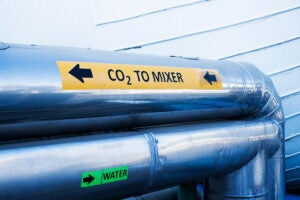If you’re a farmland owner in the Midwest, don’t be surprised if the topic of carbon capture pipelines comes up at the local diner.
According to a spring 2024 Purdue University Ag Economy Barometer, 18 percent of farmers surveyed reported having discussions with companies about carbon capture utilization and storage easements, compared with just 12 percent who reported similar discussions involving solar leases. That report follows one shortly before where 54 percent of farmers surveyed said they were offered a solar lease rate of $1,000 per acre, and 27 percent were offered $1,250 or more.
Make no mistake, the carbon capture team is bringing comparable offers when it comes to competing to obtain right-of-way easements alongside highways and fields.
But don’t be surprised if your neighbors are less than ecstatic about the prospect of carbon pipelines coming through the area. A critical component of President Joe Biden’s efforts to battle carbon-related climate change, most Americans in the Heartland remain in the dark about the growth of carbon capture, utilization, and storage (CCUS) systems, which now comprise more than 5,000 miles of pipelines and commercial-scale projects in this country alone. But the infant industry is already storing upward of 20 million metric tons of carbon dioxide (CO2) annually, as tallied by the U.S. Department of Energy.
According to a Princeton University study, some proponents hope to expand this into a 60,000-plus mile pipeline network crisscrossing the nation.

For farmland owners in key areas, this is becoming a hot topic, as a CCUS requires underground pipelines, which inevitably run by their property. Of course, private companies are offering compensation in return for the easements, but the proverbial jury is still out on whether the deals are worth it.
Plus, many throughout America’s prime farmlands are concerned about dangers and the long-term effect on soil health.
What Are CCUS?
If this is news to you, you’re not alone, although the topic has been burning hot in recent years, particularly with notable events such as a pipeline explosion in Satartia, Mississippi, in February 2020. That pipeline rupture and ensuing gas leak resulted in the evacuation of more than 200 people, 45 of whom were hospitalized, some rendered unconscious from the CO2 poisoning.
An example of a CCUS is explained in a published announcement by Agriculture and Natural Resource Educators with the Purdue Extension program describing a proposed Benton County, Indiana, facility. According to the announcement, the CCUS was proposed for location due to the sandstone layers some 3,000 feet below the surface there, which could serve as a place for geological sequestration for CO2 generated in the town of Whiting, Indiana, a suburb of Chicago about 95 miles to the north of Benton County. The approximately 2,000-foot thick Mount Simon Sandstone layer is porous, with 20 percent to 30 percent of its porous space filled with a mix of air and salty brine two to three times saltier than seawater.
If used as a CCUS, the CO2 would be transported from Whiting to the Benton County location by way of an underground pipeline, and then pumped down vertical wells to be diffused into the sandstone, where it would be trapped in the pores. Over time, some of it would become constituent with the brine, while the rest would become mineralized. The underground pipeline was proposed to run along the Illinois and Indiana border, and then branch off laterally.
Obviously, CCUS can be hard to come by as the geological formation has to be appropriate. As everyone in rural America knows, pipelines running alongside highways inevitably come into contact with farm ground, and it’s into the depths of the Earth beneath the fields where most us this CO2 will likely go.
Risks and rewards
At present, the U.S. has more CCUS than any nation in the world at more than 5,000 miles and growing. But that number pales in comparison to the some 229,287 total miles of gas and oil pipelines. Nearly all of the concerns people have with CCUS mirror those with other types of pipelines.
In the 2020 pipeline rupture in Mississippi, a greenish, strange smelling fog resulted around the town. As a gas, CO2 can asphyxiate people and livestock, and given the high pressure in which it’s transported within the pipeline, a rupture can produce a zipper-like effect. Members of Sierra Club chapters throughout the Midwest have spoken out in concern of the potential effects in environmental terms.
In some areas, farmers complain their crop yields could be negatively affected by the presence of CO2 pipelines in a manner similar to oil pipelines, citing studies that show lower yields even 10 years after the construction was completed.
Last year some Iowa farmers challenged proposals to construct a $5.5 billion pipeline that would have transported CO2 from ethanol plants across the Midwest to North Dakota, citing these yield concerns. That project featured a standoff between South Dakota farmers and construction crews, which made national headlines.
That project featured an upfront cash offer from developers of 240 percent of the area farmers’ crop value if their land was to be part of the 50-foot easement alongside roadways where the pipeline would run. The 240 percent broke down to 100 pecent of estimated crop loss for the first year, 80 percent the second year, and 60 percent the third year. Famers opposed to the measure cited concerns involving the long-term effect of displaced topsoil and construction debris.
Meanwhile, other farmers are positive about the move, as they argue the CCUS bolster the corn-based ethanol industry, as well as other ag-related businesses, like heavy equipment manufacturing.
The path moving forward
There’s no question that U.S. policy concerning climate change will continue driving the discussion of carbon sequestration. Irrespective of the coming presidential elections, the growth of CCUS is likely to continue, whether or not it ever reaches the same levels as gas and oil pipelines.

For owners of farmland throughout the Midwest and even some parts of the South are certain to encounter these offers, just like they are from companies hoping to place solar panels or wind turbines on their property. As with all things, knowledge makes the difference, and it’s better to be informed than not when the discussion arises.
Brian Boyce is an award-winning writer living on a farm in west-central Indiana.



